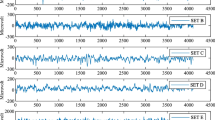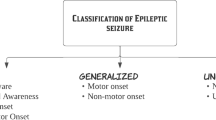Abstract
Purpose
An electroencephalogram (EEG) is usually considered to be a method to examine electrical activity in the brain during a medical consultation. EEGs help to diagnose various diseases, such as epilepsy. As EEG signals are nonlinear, they are difficult to use for diagnoses without processing. The purpose of this research is to propose a framework to detect focal and non-focal EEG signals.
Methods
To improve diagnostic accuracy, we performed signal-image transformation using a recurrence plot (RP). The process involved the following stages: (i) signal-to-image conversion, (ii) image resizing, (iii) deep feature extraction and ensemble feature generation, and (iv) binary classification and fivefold cross validation. The EEG detection work was performed using individual pretrained models, and the ensemble deep features (EDF) approach was then implemented to classify the EEG signal being considered.
Results
Using the VGG16 scheme, this methodology was tested and validated on the Bern-Barcelona EEG dataset, and the results confirmed that a detection accuracy of > 96% was achieved using the random forest (RF) classifier.
Conclusion
The proposed ensemble deep features method is superior for classifying EEG signals into focal/non-focal categories. We propose that this method be tested and validated in actual clinical settings.







Similar content being viewed by others
References
Acharya, U. R., Fernandes, S. L., WeiKoh, J. E., Ciaccio, E. J., Fabell, M. K. M., Tanik, U. J., ... & Yeong, C. H. (2019). Automated detection of Alzheimer’s disease using brain MRI images–a study with various feature extraction techniques. Journal of Medical Systems, 43(9), 302.
Fernandes, S. L., Tanik, U. J., Rajinikanth, V., & Karthik, K. A. (2019). A reliable framework for accurate brain image examination and treatment planning based on early diagnosis support for clinicians. Neural Computing and Applications. https://doi.org/10.1007/s00521-019-04369-5
Manickavasagam, K., Sutha, S., & Kamalanand, K. (2014). Development of systems for classification of different plasmodium species in thin blood smear microscopic images. Journal of Advanced Microscopy Research, 9(2), 86–92.
Muthu, B., Sivaparthipan, C. B., Manogaran, G., Sundarasekar, R., Kadry, S., Shanthini, A., & Dasel, A. (2020). IOT based wearable sensor for diseases prediction and symptom analysis in healthcare sector. Peer-to-Peer Networking and Applications, 15, 1–12.
Dey, N., Rajinikanth, V., Shi, F., Tavares, J. M. R., Moraru, L., Karthik, K. A., ... & Emmanuel, C. (2019). Social-Group-Optimization based tumor evaluation tool for clinical brain MRI of Flair/diffusion-weighted modality. Biocybernetics and Biomedical Engineering, 39(3), 843–856.
Mahmud, M., Kaiser, M. S., Hussain, A., & Vassanelli, S. (2018). Applications of deep learning and reinforcement learning to biological data. IEEE Transactions on Neural Networks and Learning Systems, 29(6), 2063–2079.
Kaiser, M. S., Chowdhury, Z. I., Al Mamun, S., Hussain, A., & Mahmud, M. (2016). A neuro-fuzzy control system based on feature extraction of surface electromyogram signal for solar-powered wheelchair. Cognitive Computation, 8(5), 946–954.
Mahmud, M., & Vassanelli, S. (2016). Processing and analysis of multichannel extracellular neuronal signals: State-of-the-art and challenges. Frontiers in Neuroscience, 10, 248.
Bakiya, A., Kamalanand, K., & Rajinikanth, V. (2018). Assessment of electromyograms using genetic algorithm and artificial neural networks. Evolutionary Intelligence. https://doi.org/10.1007/s12065-018-0174-0
Wang, Y., Shi, F., Cao, L., Dey, N., Wu, Q., Ashour, A. S., ... & Wu, L. (2019). Morphological segmentation analysis and texture-based support vector machines classification on mice liver fibrosis microscopic images. Current Bioinformatics, 14(4), 282–294.
Bhandary, A., Prabhu, G. A., Rajinikanth, V., Thanaraj, K. P., Satapathy, S. C., Robbins, D. E., ... & Raja, N. S. M. (2020). Deep-learning framework to detect lung abnormality: A study with chest X-Ray and lung CT scan images. Pattern Recognition Letters, 129, 271–278.
Kandhasamy, J. P., Balamurali, S., Kadry, S., & Ramasamy, L. K. (2019). Diagnosis of diabetic retinopathy using multi level set segmentation algorithm with feature extraction using SVM with selective features. Multimedia Tools and Applications. https://doi.org/10.1007/s11042-019-7485-8
Krishnan, P. T., Balasubramanian, P., & Umapathy, S. (2020). Automated heart sound classification system from unsegmented phonocardiogram (PCG) using deep neural network. Physical and Engineering Sciences in Medicine, 15, 1–11.
Thanaraj, K. P., Parvathavarthini, B., Tanik, U. J., Rajinikanth, V., Kadry, S., & Kamalanand, K. (2020). Implementation of deep neural networks to classify EEG signals using Gramian angular summation field for epilepsy diagnosis. arXiv preprint arXiv:2003.04534.
Vicnesh, J., Wei, J. K. E., Oh, S. L., Arunkumar, N., Abdulhay, E. W., Ciaccio, E. J., & Acharya, U. R. (2020). Autism spectrum disorder diagnostic system using HOS Bispectrum with EEG signals. International Journal of Environmental Research and Public Health, 17(3), 971.
Acharya, U. R., Sudarshan, V. K., Koh, J. E., Martis, R. J., Tan, J. H., Oh, S. L., ... & Chua, C. K. (2017). Application of higher-order spectra for the characterization of coronary artery disease using electrocardiogram signals. Biomedical Signal Processing and Control, 31, 31–43.
Krishnan, P. T., & Balasubramanian, P. (2016, December). Automated EEG seizure detection based on S-transform. In 2016 IEEE International Conference on Computational Intelligence and Computing Research (ICCIC) (pp. 1–5). IEEE.
Thanaraj, P., & Parvathavarthini, B. (2017). Multichannel interictal spike activity detection using time–frequency entropy measure. Australasian Physical & Engineering Sciences in Medicine, 40(2), 413–425.
Krishna, N. M., Sekaran, K., Vamsi, A. V. N., Ghantasala, G. P., Chandana, P., Kadry, S., ... & Damaševičius, R. (2019). An efficient mixture model approach in brain-machine interface systems for extracting the psychological status of mentally impaired persons using EEG signals. IEEE Access, 7, 77905–77914.
Krishnan, P. T., Raj, A. N. J., Balasubramanian, P., & Chen, Y. (2020). Schizophrenia D Schizophrenia detection using multivariate empirical mode decomposition and entropy measures from multichannel EEG sentropy measures from multichannel EEG signal. Biocybernetics and Biomedical Engineering, 40(3), 1124–1139.
Andrzejak, R. G., Lehnertz, K., Mormann, F., Rieke, C., David, P., & Elger, C. E. (2001). Indications of nonlinear deterministic and finite-dimensional structures in time series of brain electrical activity: Dependence on recording region and brain state. Physical Review E, 64(6), 061907.
Lin, H., & Rajinikanth, V. (2018). Normality evaluation of EEG signals based on amplitude level and entropy values. International Journal of Signal Processing Systems, 6(3), 22–26.
Acharya, U. R., Fujita, H., Sudarshan, V. K., Bhat, S., & Koh, J. E. (2015). Application of entropies for automated diagnosis of epilepsy using EEG signals: A review. Knowledge-Based Systems, 88, 85–96.
Arunkumar, N., Ramkumar, K., Venkatraman, V., Abdulhay, E., Fernandes, S. L., Kadry, S., & Segal, S. (2017). Classification of focal and non focal EEG using entropies. Pattern Recognition Letters, 94, 112–117.
Deivasigamani, S., Senthilpari, C., & Yong, W. H. (2016). Classification of focal and nonfocal EEG signals using ANFIS classifier for epilepsy detection. International Journal of Imaging Systems and Technology, 26(4), 277–283.
Sharma, R., Pachori, R. B., & Acharya, U. R. (2015). Application of entropy measures on intrinsic mode functions for the automated identification of focal electroencephalogram signals. Entropy, 17(2), 669–691.
Sharma, M., Bhurane, A. A., & Acharya, U. R. (2018). MMSFL-OWFB: A novel class of orthogonal wavelet filters for epileptic seizure detection. Knowledge-Based Systems, 160, 265–277.
Das, A. B., & Bhuiyan, M. I. H. (2016). Discrimination and classification of focal and non-focal EEG signals using entropy-based features in the EMD-DWT domain. Biomedical Signal Processing and Control, 29, 11–21.
Bhattacharyya, A., Pachori, R. B., Upadhyay, A., & Acharya, U. R. (2017). Tunable-Q wavelet transform based multiscale entropy measure for automated classification of epileptic EEG signals. Applied Sciences, 7(4), 385.
Bhattacharyya, A., Sharma, M., Pachori, R. B., Sircar, P., & Acharya, U. R. (2018). A novel approach for automated detection of focal EEG signals using empirical wavelet transform. Neural Computing and Applications, 29(8), 47–57.
Chua, K. C., Chandran, V., Acharya, U. R., & Lim, C. M. (2011). Application of higher order spectra to identify epileptic EEG. Journal of Medical Systems, 35(6), 1563–1571.
Funding
The authors declare that no funds, grants, or other support were received during the preparation of this manuscript.
Author information
Authors and Affiliations
Corresponding author
Ethics declarations
Competing interest
The authors have no relevant financial or nonfinancial interests to disclose.
Rights and permissions
Springer Nature or its licensor (e.g. a society or other partner) holds exclusive rights to this article under a publishing agreement with the author(s) or other rightsholder(s); author self-archiving of the accepted manuscript version of this article is solely governed by the terms of such publishing agreement and applicable law.
About this article
Cite this article
Sun, Y., Yang, C., Xu, Z. et al. Recurrence Plot-Assisted Detection of Focal/Non-focal EEG Signals Using Ensemble Deep Features. J. Med. Biol. Eng. 43, 176–184 (2023). https://doi.org/10.1007/s40846-023-00785-0
Received:
Accepted:
Published:
Issue Date:
DOI: https://doi.org/10.1007/s40846-023-00785-0




